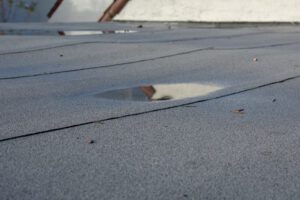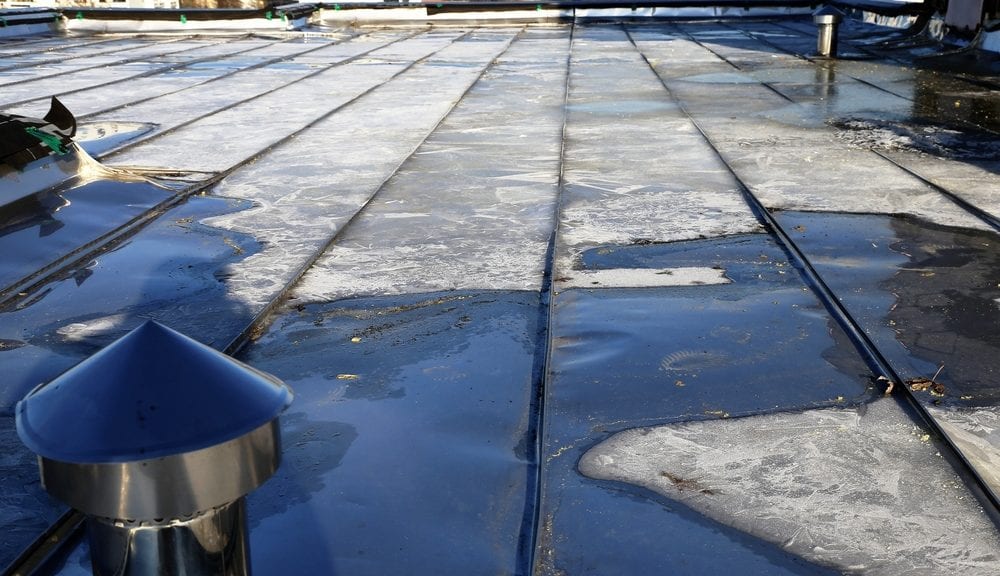When you own a commercial building, your roof is often the most crucial component protecting your property from the elements. That’s why it’s especially important to ensure that it’s always well-maintained and provides the waterproof seal you need. Regular inspections by a professional commercial roofing contractor can help with this responsibility.
Eventually, though, all buildings will need a roof replacement. Luckily, your roofing contractor can spot some warning signs you need a new roof during their regular inspections. Whether it’s because there are cracks in the roof, the roofing material is old, or some other sign, you can prepare and budget for a roof replacement if you heed the warning signs.
Learn more about these tell-tale indicators in today’s blog post. For a professional roofing inspection to determine your roof’s condition, schedule your estimate with us now!
1. YOU’VE GOT PROBLEMS WITH MOISTURE
One of the top warning signs that you need a new roof is roof leaks and other water problems. Water infiltration can cause a wide array of damages, not only to your commercial roof but also to your building’s environmental controls, such as plumbing, heating and ventilating, air-conditioning, electrical, etc. When insulation gets wet, it does a number on your utility costs. It goes from being an insulator, saving you money, to a conductor, costing you additional money to heat and cool the building.
Insect infestation is another potential consequence of moisture problems. Bugs are often attracted to damp, dark places, and your roof can be a prime area for that. Costs to exterminate insects can add up, not to mention code violations and disruptions to business operations.
You’ll know you have moisture problems if there are any visible water stains or marks on your building’s walls or ceilings. Another sign can include an increase in high humidity. Ignoring moisture problems on your roof can easily get out of hand, so if you notice any obvious signs, it’s best to contact your roofing contractor as soon as possible.
2. YOU’VE NOTICED BUBBLING ON THE ROOF
Customers sometimes ask us, “How do you know when you need a new roof?” One of the most obvious signs is bubbling on the roof surface. Bubbling is something you’re only going to see if you’re actually on the roof. Bubbles can be caused by moisture buildup under chemically adhered single-ply roofing or built-up roofing.
The more bubbles you have, the less time you have before your roof is compromised beyond repair, and it’s one of the most time-sensitive signs you need to replace your roof. If you have too many bubbles, you’ll need a new roof to avoid further damage to your property. A trained roofing professional can give you a reasonable estimate of the time you have left before your roof needs to be repaired or replaced.
3. YOUR ROOF’S FLASHING IS MISSING, DAMAGED, OR DISLODGED
Flashing is fundamental to your roof’s integrity, as it secures the roofing materials and prevents water and other debris from compromising the roofing system. When you have bent, dislodged, or damaged flashing, it breaks the seal, allowing water to penetrate and build up on an area of your roof. Water penetrating your roofing material can lead to a leaky roof.
Time and weather, such as snow and ice, can both cause damage to flashing. Be sure flashing is installed only by a trained professional and regularly inspected to avoid costly repairs.
4. YOU HAVE CLOGGED DOWNSPOUTS

One of the most common warning signs you need a new roof is frequently clogged downspouts. It’s always advisable to check your exterior downspouts after heavy rain. If you see very little water coming out—or none at all—there may be a problem elsewhere. A clogged downspout can lead to moisture building up on your roof, which can cause bubbling and other damages related to moisture buildup.
Ponding and pooling water on the roof can also be a good indicator of a clogged downspout, so even if you haven’t had any severe rain, the warning signs you need to replace your roof may be present. These signs of water damage or even a sagging roof indicate that your roof’s life is nearing its end.
5. YOUR ROOF IS JUST OLD
The fifth sign you may need a roof replacement is the age of your roof. Depending on your state and the material used to cover your roof, your roof could be too old to be appropriately insured or just old enough that it’s more of a liability than protection for your building. Your contractor will be able to tell you if the roof is at its end, but aside from that, any visible signs of failure or damage can also indicate an old roof.
If you bought the commercial property recently and didn’t have the maintenance records of when the roof was last replaced, a quality roof inspection is in order. Roofing professionals will come to your building and check for roof leaks, damage, and other common signs that indicate age. Then, you’ll better understand whether you need a roof replacement or repair.
6. YOU’VE HAD WORK DONE BY OTHER TRADE PROFESSIONALS RECENTLY
Maybe you’ve had work done by a different contractor, and they had to use your roof or alter it somehow. It helps to contact a roofing-specific contractor to ensure the other trade professionals didn’t cause any damage or create any problems when they last accessed the roof.
Any damage they may have incurred on the roof can be repaired, but depending on the extent of the damage, you might need to replace the roofing materials. There are many roof types available for your warehouse, and a professional roofer can help advise you on the best material for your building.
7. ROOFING MATERIAL HAS HOLES, IS RIPPED OR TORN

A roof replacement may also be necessary if your roof surfaces show signs of damage. When there are visible signs of damage to your roof, you most definitely want to call your preferred roofing contractor. Whether due to recent weather or gradual deterioration, even the smallest tears can lead to significant problems.
8. Musty Odors Inside Your Building
Finally, one of the warning signs you need a new roof that you can tell from inside the building is musty odors. Do you smell a strong odor in some areas of your warehouse or manufacturing facility? Do you or your workers frequently experience allergy-type symptoms, such as wheezing, sneezing, and congestion? If you answered yes to any of these questions, it might be time for a new roof.
Problems with moisture on your roof and insufficient roof ventilation are some of the reasons your commercial building smells musty. You can first try to adjust humidity levels and cleaning to see if that takes care of the musty odor, but if not, a roof inspection is necessary to see if you need a roof replacement.
Have You Noticed Some of These Warning Signs You Need a New Roof?
It can be hard to spot these warning signs that you need a new roof when you don’t go on it very often. Not only do proper safety precautions have to be taken when working on a roof, but untrained people will not spot the same warning signs a professional roofer will. That’s why it’s essential to contact us to do your regular roof inspections. We prioritize safety, as evident by our in-house safety director, who oversees job sites.
We’ll be able to safely inspect your roof and provide recommendations on if and when you need a roof replacement. Since replacing a commercial roof can be expensive, it’s important to spot these signs early, so you can properly prepare and budget for the roof replacement. In the meantime, if you notice any of the obvious signs inside or outside your commercial property, it’s important to contact us right away for your roofing estimate.


